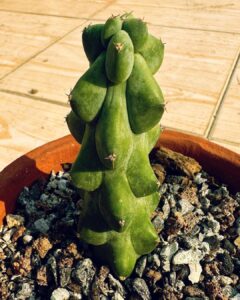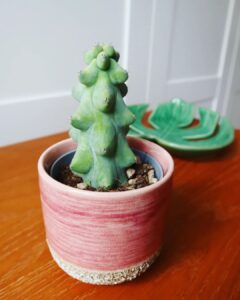Follow the Boobie Cactus Care and Growing Guide and master the art of nurturing and maintaining this unique and beautiful plant.
If you’re a beginner or seeking a low-maintenance houseplant, the Boobie Cactus is an excellent choice. This Boobie Cactus Care Guide provides essential tips and guidance for nurturing this popular cactus variety known for its distinctive look and effortless care requirements.
Botanical Name: Myrtillocactus geometrizans ‘Fukurokuryuzinboku’
USDA Zones: 8 to 11
Check Bellis Perennis Growing Guide and Uses
About Boobie Cactus

Native to Mexico, Boobie Cactus is quite popular in the Cactaceae family. The unique round shape of the Boobie Cactus got its name, as it closely resembles a small breast or “boob.” It features a green surface with small white spines. The plant also displays vibrant flowers in shades of pink, red, and yellow.
Apart from its attractive appearance, the Boobie Cactus offers numerous health benefits. This plant has a long history in traditional medicine, for its effectiveness in treating various ailments, including fever, indigestion, and arthritis. Additionally, it has anti-inflammatory properties, making it a good option for skin conditions like eczema and psoriasis.
Read about Betel Leaf Plant Care and Growing Guide
Propagating Boobie Cactus

Follow these steps to grow Boobie Cactus:
From Offsets:
- The Boobie Cactus produces offsets or “pups” that can be separated from the parent plant and replanted to establish new plants.
- Select a well-draining pot and fill it with a suitable cactus or succulent potting mix.
- Gently remove the offsets from the parent plant, taking care not to damage them. Allow the offsets to dry for a few days to prevent rotting.
- Once the offsets have formed a callus, plant them in the prepared potting mix.
- Ensure they are planted deep enough to provide stability and prevent them from toppling over.
Check Anthurium Wendlingeri: Growing and Care Guide
From Seeds:
Boobie Cactus seeds can be obtained from a reliable supplier or collected from mature plants. To start the germination process, follow these steps:
- Prepare a pot or seed tray filled with a well-draining cactus or succulent soil mix.
- Scatter the Boobie Cactus seeds evenly over the surface of the soil.
- Gently press them into the soil to ensure good seed-to-soil contact.
- Lightly water the soil, taking care not to overwater, and place the pot or tray in a dark location.
- Boobie Cactus seeds typically take around two to four weeks to germinate.
- During this period, maintain a consistently moist environment without saturating the soil.
Learn How to Grow Toona Sinensis ‘Flamingo’ Tree
Ideal Pot Size for Growing Boobie Cactus
Begin by planting it in a 5-6 inch pot, which should be suitable for around 2-3 years. As the cactus grows and expands, you can consider repotting it into a container one size larger than its current one.
Follow Annatto Achiote Care guide
Ideal Growing Conditions for Boobie Cactus

Sunlight
It requires bright but indirect light. Direct sunlight can be harmful, leading to leaf and stem damage.
When growing the Boobie Cactus indoors, it is advisable to position it near a south-facing window that receives ample sunlight throughout the day. However, ensure that the plant is protected from direct sunlight.
If growing this cactus outdoors, select a location that provides partial shade during the hottest day. This helps protect the plant from excessive sun exposure and potential damage.
Soil
Use a cactus soil mix for growing the Boobie Cactus. Alternatively, you can create your own by combining equal parts of sand, perlite, and peat moss.
Avoid using regular garden soil, as it can lead to waterlogging and adversely affect the plant’s health.
Check Paintbrush Lily Growing Guide
Watering
It is crucial to maintain even moisture in the soil without allowing it to become soggy. Watering the plant when the top inch of the soil has dried out.
In the summer season, more frequent watering may be required due to increased evaporation. However, it is important to exercise caution and avoid overwatering, as this can result in the development of root rot.
Temperature and Humidity
It prefers temperatures ranging from 65-85°F (18-29°C). It can tolerate lower humidity levels, but it is recommended to maintain a humidity range of 40-60% for optimal growth.
Learn Salsify Care in Pots
Boobie Cactus Care

Fertilizer
During the growing season, use a balanced fertilizer, such as a 10-10-10 or 20-20-20, at half strength. Apply the fertilizer once a month. It’s important to avoid using fertilizers with high nitrogen content, as this can lead to leggy growth in the plant.
Remember not to fertilize this cactus during winter, as it is a period of dormancy, and the plant does not require additional nutrients during this time.
Find How to Grow Star Cactus Succulent
Pests and Diseases
The Boobie Cactus is susceptible to common pests such as mealybugs and spider mites, as well as the risk of root rot.
- To repel mealybugs, use insecticidal soap or neem oil.
- In the case of spider mites, treat the plant using insecticidal soap, neem oil, or horticultural oil.
- To prevent root rot, it is crucial to avoid overwatering the plant. Ensure that the soil has proper drainage to prevent water accumulation.
- If root rot is observed, remove the affected plant from its pot. Trim the damaged roots and replant them in fresh, well-draining soil to promote recovery.
By following these measures, you can address pests and diseases commonly associated with these pretty cacti and help maintain their health and vitality.
Check Dischidia hirsuta ‘Red Leaf’ Growing Tips & Care Information
FAQs
Q.1. How often does the Boobie Cactus bloom?
The Boobie Cactus typically blooms once a year during the spring or summer months. However, the exact timing and frequency of blooming can vary depending on the growing conditions and plant maturity.
Q.2. Is the Boobie Cactus safe around pets or children?
The spines of this cactus can cause irritation and injury if touched or ingested. Therefore, it’s important to keep the plant out of reach of pets and children.
Q.3. Why is Boobie Cactus becoming leggy?
Insufficient light can cause Boobie Cacti to become elongated or “leggy.” This happens when the plant stretches out in search of more light. To promote compact growth, ensure your cactus receives adequate bright, indirect light. If growing indoors, consider placing it near a south-facing window or using artificial grow lights to supplement the light requirements.
Q.4. Why Is Boobie Cactus turning discolored or yellow?
Yellowing or discoloration of the cactus can indicate various issues, such as overwatering, underwatering, nutrient deficiencies, or pests.
Q.5. Can I prune the flowers of the Boobie Cactus after they have bloomed?
It is not necessary to prune the flowers of the Boobie Cactus after they have bloomed. The flowers will naturally fade and wither over time. However, suppose you prefer a tidier appearance or want to redirect the plant’s energy toward growth rather than seed production. In that case, you can carefully trim off the faded flowers using clean pruning shears. Be cautious not to damage the healthy portions of the plant while pruning.
Q.6. Is Boobie Cactus rare?
If you’re curious about this Cactus and whether it’s rare, here’s the scoop: in its home country of Mexico, it is not rare at all. It can grow from seeds on dry, rocky slopes and in desert areas. However, if you’re outside of Mexico, you might not see it as often, especially as a part of indoor gardens or succulent collections. In those places, it could be considered a unique and uncommon addition.



